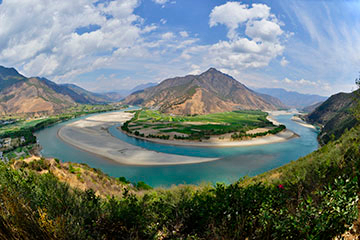Name in Chinese: 大理 Dà Lǐ [da:li]
Location: West Central Yunnan, China, GMT+8
Population: 3.6 million as a prefecture, 350,000 living in the city proper
Telephone Code: +86872
Keywords: the Bai Nationality, Dali Old Town, Erhai Lake
The name Dali does not only refer to the City of Dali, but also Dali Old Town and Dali Bai’s Autonomous Prefecture. The prefecture lies in West Central Yunnan. Its capital is called the City of Dali, 340 kilometers(211 miles) to the northwest of Kunming. Dali has a long history. It is notable for the old town, the beautiful Erhai Lake and the Bai’s tie-dye. The old town can be traced back to the early eighth century, when the Nanzhao Kingdom(738-902) was established. Erhai Lake is the second largest freshwater lake in Yunnan. There’s nothing more blissful and restful than boating on such a lovely lake. The prefecture is mainly inhabited by five ethnic groups, namely, the Han, the Bai, the Yi, the Na-khi and the Hui. They each maintain their own cultural traditions. The Bai people are good at tie-dying. The Bai’s tie-dye is one of the most famous traditional handicrafts in Yunnan Province.
Attractions
Dali Old Town
Dali Old Town was founded in 1382. It covers an area of 300 hectares(741 acres). It has been the homeland of the Bai people for thousands of years. It used to be the capital of both the Ancient Nanzhao Kingdom and the Ancient Dali Kingdom.
Erhai Lake
Erhai Lake is noted for its gorgeous view when the moon casts a silver glow over the lake. It lies at the foot of Cangshan Mountain. The lake measures 256 square kilometers(99 sq.mi), 22 meters(72 feet) at its deepest point . It is the second largest freshwater lake in Yunnan Province and the seventh largest in Mainland China. Erhai Lake is one of the must-see attractions in Yunnan.
Chongsheng Temple
Chongsheng Temple is situated on the eastern slope of Cangshan Mountain, overlooking Erhai Lake. It can be dated back to the early eighth century. There are three pagodas in the compound of Chongsheng Temple. The pagodas are the landmark of Dali. The main pagoda stands in the middle of the three pagodas. It is called Qianxun Pagoda or Wenbi Pagoda by locals, is a sixteen-storied building with a height of 69.13 meters(227 feet). Qianxun Pagoda boasts a long history of over 1,200 years. The other two are smaller in height than the main pagoda. Both are ten-storey pagodas which are 42.19 meters(138 feet) high.
Xizhou Ancient Town
Xizhou Ancient Town is situated on the west shore of Erhai Lake, 18 kilometers(11 miles) to the north of Dali Old Town. It boasts a long history of over 1,000 years and shows the authentic Bai People’s cultural tradition and absolutely unique architecture. The Residence of Yan’s Family is a typical example of the Bai People’s traditional architecture. The house was constructed in 1907. It was the property of Yan Zizhen, who was one of the richest businessmen in Yunnan Province in the early twentieth century. The dwelling measures 2,478 square meters(2,964 sq.yd). Nowadays, it has become a folk museum.
Climate
The four seasons are not that distinct in Dali due to its relatively high altitude and low latitude. Generally, Dali has warm springs, moderate summers, windy autumns and mild winters. The tropical latitude of Dali means that tourists need to bring some suncream and sunhats when they travel to Dali. The temperature in Dali ranges from 6℃(42.8°F) to 19℃(66.2°F) in spring, 14℃(57.2°F) to 25℃(77°F) in summer, 17℃(62.6°F) to 25℃(77°F) in autumn, and 7℃(46.4°F) to 20℃(68°F) in winter. Both spring and autumn are the best time to travel to Dali. The spring comes in February and goes in April, while the autumn lasts from September to November.
Food and Drinks
The locals consume rice, wheat, corn(maize) and potato as their staple food. They love spicy dishes and pickles. The Bai’s cooking features a mixed flavour, which tastes sour, spicy and sweet. The dishes popular among the Bai people are the Fish Casserole, the Tofu Casserole and the Cured Pig’s Liver. The Three-Course Tea is their favourite traditional drink. It is an absolutely unique method of drinking tea. A host usually offers his guests three cups of tea, namely the Bitter Tea, the Sweet Tea and the Tea with Nice Aftertaste. The Three-Course Tea has been designated as a national intangible cultural heritage.
How to Get to Dali
Dali Huangcaoba Airport is located 13 kilometers to downtown Dali. It operates flights to some major cities within Mainland China, such as Beijing, Shanghai, Chengdu, Xi’an and Kunming. However, most of the tourists prefer to travel to Dali by car or bullet train from Kunming.

